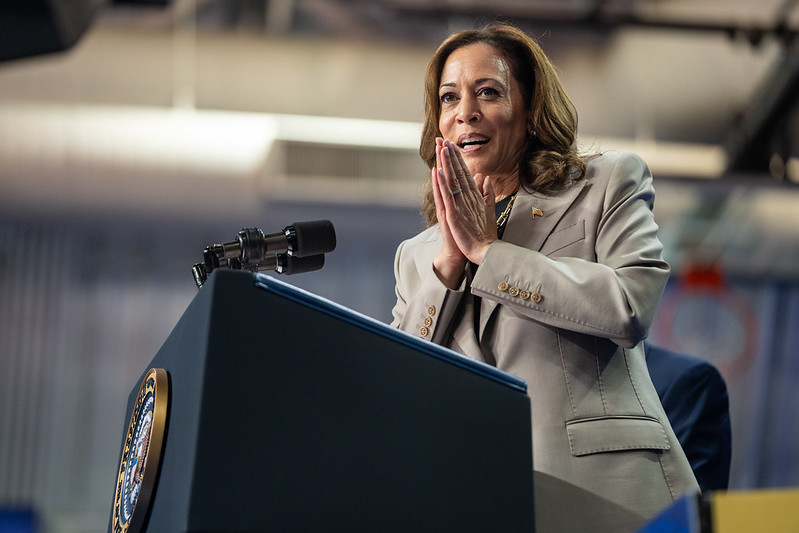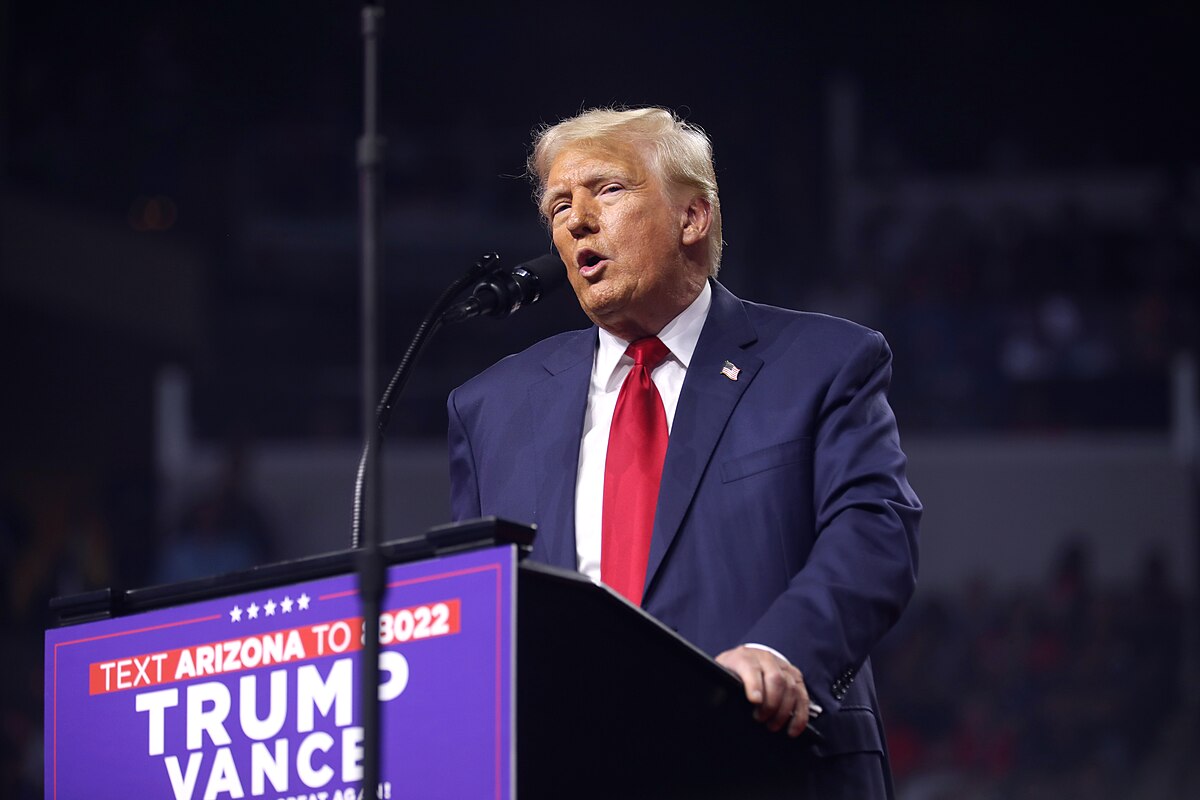

With factory states like Pennsylvania and Wisconsin considered keys to the election, both presidential candidates are making their pitch to manufacturing voters.
I will start out this blog with our usual disclaimer: The Alliance for American Manufacturing (AAM) is a nonpartisan institution, and as such, we do not endorse political candidates, whether they are running for Congress or the presidency or a local city council spot.
We do, however, pay attention to what candidates say on the campaign trail about our issues, and we encourage all those running for public office to put forth their preferred policies to grow American manufacturing. After all, some of these candidates will end up in positions of power — it’s good to know ahead of time what they plan to do.
And this past week, the two candidates running for the most powerful position in the world have made it a point to talk about manufacturing.
Both Vice President Kamala Harris and former President Donald Trump have spoken at length in recent days about their plans to grow factory jobs and U.S. production. Harris, the Democratic presidential nominee, unveiled her ideas during a big speech on the economy in Pittsburgh. Trump, the GOP’s pick, pledged to “reclaim America’s manufacturing power” during several campaign stops, including in Michigan.
I’ll get into each of their plans in a moment, but suffice to say it was striking to see both Harris and Trump suddenly and specifically shift to manufacturing. While both have certainly touched on manufacturing issues throughout the campaign — including during their lone debate — until now, neither has really zeroed in on manufacturing as a main component of their campaign messaging.
The electoral map may provide the biggest clue for this emerging strategy. Several states that have a robust manufacturing presence are up for grabs, including Wisconsin and North Carolina. While the other swing states — Georgia, Arizona and Nevada — aren’t traditionally part of the “Industrial Heartland,” manufacturing is a growing part of their economies. Georgia, for example, is steadily growing its manufacturing sector, especially in machinery, fabricated metals, and solar. Arizona, meanwhile, is home to manufacturing facilities for companies like Intel and Honeywell Aerospace, and is seeing that sector grow thanks to planned semiconductor facilities; Nevada is undergoing a manufacturing boom and hosts Tesla’s Gigafactory.
And then there’s Pennsylvania, viewed by many as the state that will decide the election. I probably don’t need to give you the full history of manufacturing in Pennyslvania, but suffice to say, it’s real important to the Keystone State’s economy.
It was no surprise then that when Harris decided to officially unveil her strategy for growing the middle class, including via manufacturing, she did so in the Steel City. I’ll start with her plan.
Harris: “America’s economic strength has been tied to our industrial strength.”
Harris’s speech before a crowd at Carnegie Mellon University touched on a lot of issues, from artificial intelligence to prescription drug costs to tax reform. For the purposes of this blog, I’ll focus on issues directly tied to manufacturing.
The VP included manufacturing as part of “the third pillar of our opportunity economy,” noting her aim is to lead the world “in the industries of the future and making sure America, not China, wins the competition for the 21st century,” echoing a message often shared by the current commander-in-chief.
Harris did not shy away from talking about the importance of industrial policy, calling it a key to our country’s economic success:
One of the recurring themes in American history is that when we make an intentional effort to invest in our industrial strength, it leads to extraordinary prosperity and security, not only for years but for generations.
Think of Alexander Hamilton having the foresight to build the manufacturing capabilities of our new nation. Think of Lincoln and the transcontinental railroad. Think of Eisenhower and the Interstate Highway System; Kennedy committing America to win the space race and spurring innovation across our society.
From our earliest days, America’s economic strength has been tied to our industrial strength, and the same is true today.
Harris pledged that as president, the United States will invest in sectors like biomanufacturing, aerospace, AI, and quantum computing. She said the U.S. will expand its efforts in “clean energy innovation and manufacturing,” which has seen growth thanks to industrial policy like the Inflation Reduction Act. The goal, Harris said, is to ensure “the next generation of breakthroughs from advanced batteries to geothermal to advanced nuclear are not just invented but built here in America by American workers.”
“And we will invest in the industries that, for example, made Pittsburgh the “Steel City” by offering tax credits for expanding good union jobs in steel and iron and manufacturing communities like here in Mon Valley,” Harris continued. “And across all these industries of the future, we will prioritize investments for strengthening factory towns — this is so important — for strengthening factory towns; retooling existing factories; hiring locally and working with unions, because no one who grows up in America’s greatest industrial or agricultural centers should be abandoned.”
Harris also pledged to grow apprenticeship programs and ease building requirements so factories can be built more quickly. “I will tell you this. China is not moving slowly. They’re not. And we can’t afford to, either,” Harris said.
Harris notably took a shot at Trump’s manufacturing track record in her speech, saying that “on Trump’s watch, offshoring went up and manufacturing jobs went down across our country and across our economy.” She also criticized the former president on China, arguing that “he constantly got played by China.”
“I will never hesitate to take swift and strong measures when China undermines the rules of the road at the expense of our workers, our communities, and our companies, whether it’s flooding the market with steel, inferior or at all; unfairly subsidizing shipbuilding; or hurting our small businesses with counterfeits,” Harris said. “Recall Donald Trump actually shipped advanced semiconductor chips to China, which helps them upgrade their military. Understand the impact of these so-called policies that really are not about a plan for strengthening our prosperity or our security. I will never sell out America to our competitors or adversaries. Never. Never.”
This seems like a good time to dive into what Trump has been saying on manufacturing.
Trump on a “new American industrialism”
In true Donald Trump style, it’s hard to nail down one specific message he’s been pushing over the past few weeks. Trump is, well, kind of all over the place with his remarks these days. During a speech given in the bellwether city of Erie, Pa., over the weekend, Trump touched on everything from shoplifting crime to fracking to making some frankly misguided and unfair statements about immigrants.
But at some point, Trump usually does get to talking about manufacturing issues during his campaign speeches. He stayed more on message up in Michigan on Friday, where he put forth his goal of increasing auto production in the United States. “I want German car companies to be American car companies. I want them to build their cars in this country, not in Germany. I want Asian electronics companies to become Michigan electronics companies,” Trump said.
Earlier in the week, Trump told a crowd in Savannah, Ga., that he’ll lower taxes and regulations to lure more foreign companies to build factories in the United States. Trump said he’d ease reviews and regulations to make it easier to build. Trump also said he’d appoint a manufacturing ambassador to bring more investment stateside, calling it a “new American industrialism.”
It’s impossible to talk about Trump’s plan for manufacturing, however, without talking about his pledge to significantly raise tariffs. While the Biden administration has issued strategic tariffs on a number of Chinese imports — including a 100% tariff on Chinese electric vehicle imports — the former president has said he wants to issue a broad 60% tariff on all Chinese imports and a 20% tariff on all other imports.
In recent weeks, Trump also has gone after companies with tariff threats. For example, he said he’d issue a 200% tariff on John Deere if the company moves production to Mexico.
Another Trump stance worth noting: He wants to revoke a whole lot of the Inflation Reduction Act, including rescinding unspent dollars from the landmark law. However, Politico reported that some within Trump’s orbit — including former U.S. Trade Ambassador Robert Lighthizer — have said that some of the law’s provisions designed to spur factory growth may remain in place if Trump is re-elected.
***
The most glaring difference between Harris and Trump on manufacturing policy is perhaps where their focus is. While Harris has pledged to take trade action against countries like China, most of her policy recommendations center on industrial policy designed to grow and strengthen U.S. production, particularly in critical sectors. Trump, meanwhile, has his attention turned outward, with policy proposals to encourage foreign manufacturers to relocate to the U.S. and making it far more difficult to import goods here.
To repeat, AAM does not endorse political candidates, so I won’t put forth which policy prescription we think is the better one. But what I will say that it isn’t enough just to invest in domestic production or take a strong stance against China. The U.S. needs to do both in order to grow and strengthen our manufacturing capabilities.
The next president — whether that is Harris or Trump — needs to be prepared to strongly enforce our trade laws, especially against China’s continued trade cheating. But at the same time, the next president must prioritize growing our domestic manufacturing capabilities, especially in sectors critical to our national and economic security.
As the election approaches, we’ll continue to keep an eye on what both candidates have to say about manufacturing. Stay tuned.
